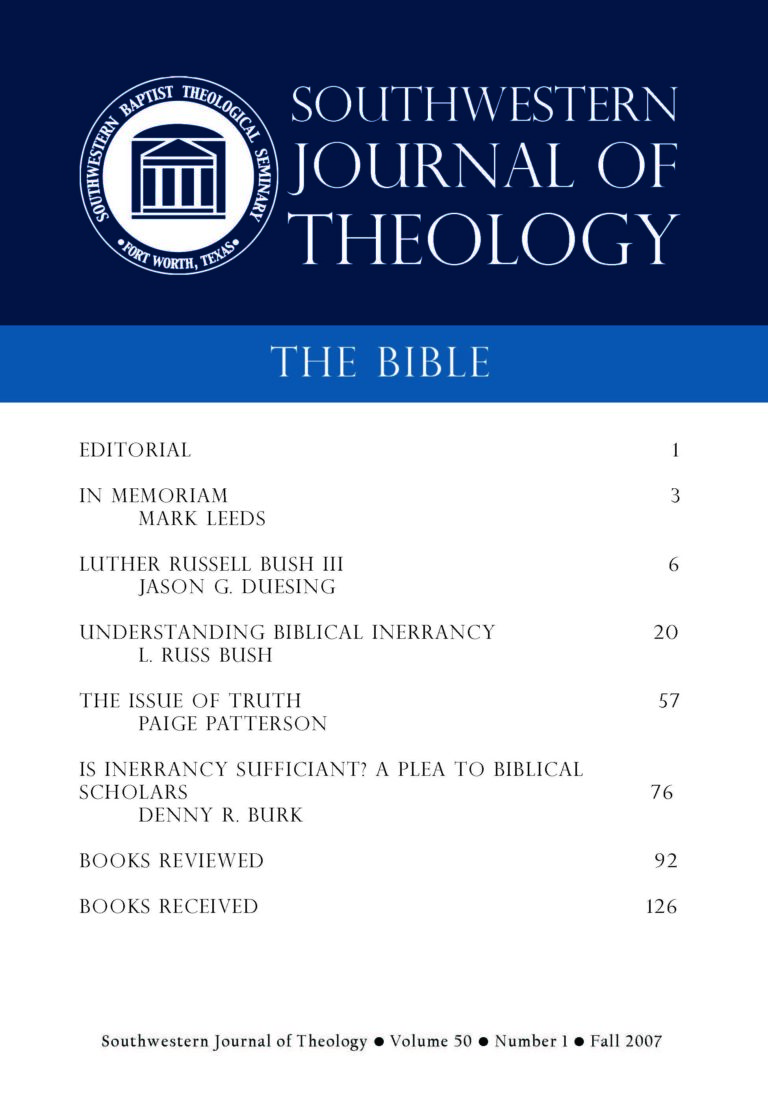
The Bible
Southwestern Journal of Theology
Volume 50, No. 1 – Fall 2007
Managing Editor: Malcolm B. Yarnell III
By A.K.M. Adam, Stephen Fowl, Kevin Vanhoozer and Francis Watson. Grand Rapids: Baker Academic, 2006. 160 pages. Softcover. $17.99.
Reading Scripture with the Church is a collection of four essays and four brief responses written by Adam, Fowl, Vanhoozer and Watson. The Winslow Lectures at Seabury-Western Theological Seminary were the original setting for the papers. Each essay recognizes the polyphonic qualities of Scripture though the authors describe the nature of this polyphony differently. The essays also intend to encourage (and perhaps to extend) the practice of theological interpretation of Scripture. There is also the common theme of resisting some of the monolithic concerns of a modern, critical approach to interpreting biblical texts. The authors present their interpretative task as an ecclesial one and one that recognizes the uniqueness of biblical texts.
Adam contends for a releasing of the constraints on biblical interpretations. He argues that the scholarly guild has sequestered biblical interpretation through its imposed guidelines for biblical inquiry. Adam hopes that more involvement of “laity” (those outside of academia, whether clergy or not) will encourage the recognition of the abundance of meaning in biblical texts. To liberate the “enclosed” meaning of texts one must recognize that the interpretative task should move beyond a near-sighted interest in verbal meaning only and grant that biblical theology is a “signifying practice.” Some signifying practices of biblical theology include listening to voices from other cultures or centuries and participation in worship.
Fowl’s essay calls attention to the “multivoiced literal sense” of Scripture mainly through the lens of the interpretative practice of Thomas Aquinas. Fowl argues that Aquinas’s understanding of literal sense allowed quite divergent interpretations to stand both as appropriate and as literal. A reason for this multilayered literal meaning is that Scripture reflects the abundance of God’s revelation. The ultimate purpose of God’s multifaceted speech is to draw humans into relationship with him.
Vanhoozer provides. more biblical rationale for his hermeneutical theories described in other works. He makes use of the master-slave imagery from Philemon to question the respective roles of authors, readers and texts. Though Vanhoozer agrees with Adam and Fowl that an overly monolithic understanding of the meaning of a text is not conducive to theology, he also grants a more significant role for firm parameters in the interpretative enterprise. Vanhoozer’s use of speech-act theory fosters his interest in the active nature of divine discourse in Scripture.
Watson offers rationale for the four-fold gospel. The four-fold gospel has been defended throughout Christian tradition for historical and theological reasons. Watson gives a significant amount of his essay to the symbolic analogies used by Irenaeus of Lyons in his apology for the four- fold gospel. While Watson does not accept the analogies wholesale, he does note that Irenaeus’s perspective is helpful to the contemporary interpreter in recognizing the fullness of the combined meaning drawn from the unique pictures of the individual gospels.
Adam’s essay provides a needful reminder that theological interpretation is not for the scholarly guild only. However, his desire to remove the restrictions on meaning raises the question of whether there are genuine, objective parameters for the interpretative task. Historians would have reservations of how Fowl uses Aquinas’s methodology in buttressing his own approach. In his response, Vanhoozer indicates the ambiguity in Fowl’s article on the multiple levels of literal sense. Some philosophers and theologians will lament that Vanhoozer continues to rely on the paradigm of speech-act theory in his hermeneutical work. However, he does interact more with biblical texts in this essay than in his previous works, though he does stop short of issuing a mea culpa. Watson’s essay could have been strengthened by following Irenaeus’s appeal to the four-fold gospel being consistent with the message of the Old Testament. According to Irenaeus, the four-fold apostolic testimony found in Matthew, Mark, Luke, and John is authoritative because it is consistent with the Hebrew Scriptures in its revelation of Christ.





